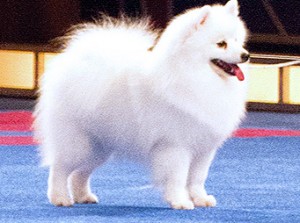Breed Priorities – The American Eskimo Dog
292 – October, 2018
BY NIKKI RIGGSBEE
 The American Eskimo Dog is one of the Spitz breeds found for centuries in northern and central Europe. They are characterized by a long, thick coat, pointed erect ears, a pointed muzzle, and a tail that typically curls over the back. A descendant of the German Spitz, the Eskie was used as a general-purpose farm dog and watch dog.
The American Eskimo Dog is one of the Spitz breeds found for centuries in northern and central Europe. They are characterized by a long, thick coat, pointed erect ears, a pointed muzzle, and a tail that typically curls over the back. A descendant of the German Spitz, the Eskie was used as a general-purpose farm dog and watch dog.
The breed comes in three sizes: toy, miniature, and standard. All three sizes are shown on the table in the conformation ring. They are very smart as well as beautiful, and they have been used in entertainment as trick and circus performing dogs.
There aren’t too many American Eskimo Dog judges, so parent club mentors and long-time breeders were also invited to contribute to a project to identify their breed’s priorities. Several in the parent club were most helpful in sending photos which were candidates as outlines – thanks so much! Often, collecting suitable photos to outline is the hardest part of conducting a survey for this series. We contacted 29 experts by email, and 22 responded. In the end, 11 completed surveys were returned.
The Eskie experts who contributed have been in the breed for an average of nearly 24 years. Those who judge have been doing so for more than 13 years on average. Most of the breeder-judges have judged their national and other Eskie specialties.
Virtues
The survey included a list of breed characteristics taken from the American Eskimo Dog standard for the experts to prioritize from most to least important. Below are the virtues in order by the experts’ average rankings, with 1 being the most important.
1. Gait with good forequarter reach and good hindquarter drive 2. Length of back slightly greater than height, approximate 1.1 to 1 ratio
3. Forequarters well-angulated
4. Topline level
5. Hindquarters well-angulated
6. As speed increases, … will single track
7. Strong and compact, but not cobby
8. Expression keen, intelligent, alert
9. Chest deep, broad, with well-sprung ribs
10. Muzzle broad, length not exceeding skull, may be slightly shorter
11. Eyes slightly oval, set well apart, dark to medium brown, rims black to dark brown
12. Ears triangular, slightly blunt-tipped, erect, set on high yet well apart
13. Coat stand-off, double, straight
14. Scissors or pincer bite
15. Richly plumed tail carried loosely on the back
16. Feet oval, compact, tightly knit, well-padded with hair
292 – October, 2018
Short URL: http://caninechronicle.com/?p=152608
Comments are closed











